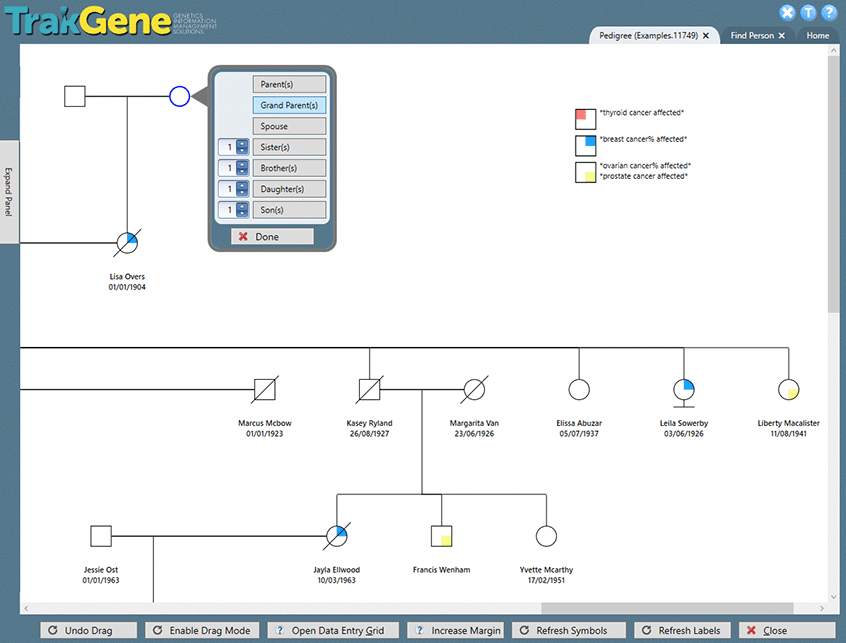
Introduction
A genetic pedigree chart drawing tool is a powerful tool for identifying inherited diseases. It is a graphical representation of a family tree that shows the relationships between family members and their genetic traits. It can be used to identify inherited diseases, such as cystic fibrosis, Huntington’s disease, and sickle cell anemia. The pedigree chart can also be used to identify the risk of a person developing a particular disease, as well as the likelihood of a person passing on the disease to their children. By analyzing the pedigree chart, medical professionals can determine the probability of a person developing a particular disease and can provide advice on how to reduce the risk.
How Can a Genetic Pedigree Chart Drawing Tool Help Identify Inherited Diseases?
The utilisation of a genetic pedigree chart is an effective means of identifying hereditary ailments. It presents a graphical overview of a family’s genetic lineage, depicting the interrelationships among its members and any heritable conditions. Through the examination of the pedigree chart, healthcare experts can detect heredity patterns and assess the probability of an individual acquiring a specific disease.
The genetic pedigree chart is composed of symbols that represent family members and their relationships. Each symbol is color-coded to indicate the gender of the individual and whether they are affected by a particular disease. The chart also includes information about the family’s medical history, such as the age of onset of a particular disease and any other relevant information.
Using a genetic pedigree chart drawing tool, medical professionals can quickly and accurately create a chart that can be used to identify inherited diseases. The tool allows users to easily add and remove family members, as well as add and remove symbols to indicate the presence of a particular disease. The tool also allows users to customize the chart to include additional information, such as the age of onset of a particular disease.
Using a genetic pedigree chart drawing tool allows them to easily create a chart that can be used to identify patterns of inheritance and determine the likelihood of a person developing a particular disease. This can help medical professionals provide better care to their patients and ensure that they receive the best possible treatment.
Exploring the Benefits of Using a Genetic Pedigree Chart Drawing Tool for Disease Identification
The use of a genetic pedigree chart drawing tool can be beneficial in a variety of ways. First, it can help researchers identify patterns of inheritance that may be associated with a particular disease. By visually representing the family’s genetic history, researchers can quickly identify any potential genetic mutations that may be responsible for the disease. This can help them narrow down the list of potential causes and focus their research efforts on the most likely culprits.
Second, a genetic pedigree chart drawing tool can help researchers track the progression of a disease within a family. By visually representing the family’s genetic history, researchers can quickly identify any potential genetic mutations that may be responsible for the disease. This can help them understand how the disease is passed down from generation to generation and identify any potential treatments or preventative measures that may be necessary.
Finally, a genetic pedigree chart drawing tool can help researchers identify any potential environmental factors that may be contributing to the disease. By visually representing the family’s genetic history, researchers can quickly identify any potential environmental factors that may be contributing to the disease. This can help them understand how the environment may be impacting the disease and identify any potential treatments or preventative measures that may be necessary.
Overall, the use of a genetic pedigree chart drawing tool can be a powerful tool for identifying and tracking genetic diseases. By visually representing the family’s genetic history, researchers can quickly identify any potential genetic mutations or environmental factors that may be contributing to the disease. This can help them narrow down the list of potential causes and focus their research efforts on the most likely culprits. Additionally, it can help them track the progression of the disease within a family and identify any potential treatments or preventative measures that may be necessary.
The Role of Genetic Pedigree Chart Drawing Tools in Diagnosing Inherited Diseases
Inherited diseases are a major cause of morbidity and mortality worldwide. As such, it is important for medical professionals to be able to accurately diagnose these conditions. One of the most important tools for diagnosing inherited diseases is the genetic pedigree chart. This chart is used to trace the inheritance of a particular gene or trait through a family.
Genetic pedigree charts are traditionally drawn by hand, but in recent years, computer-based tools have been developed to help medical professionals create these charts more quickly and accurately. These tools allow users to enter information about family members, such as their gender, age, and any known genetic conditions, and then generate a chart that shows the inheritance of the gene or trait in question.
The use of these tools has been shown to improve the accuracy of diagnosis for inherited diseases. By providing a visual representation of the inheritance pattern, these tools can help medical professionals identify patterns that may indicate a particular condition. For example, if a particular gene is known to be inherited in an autosomal dominant pattern, the chart can help medical professionals identify which family members are likely to be affected.
In addition to improving accuracy, these tools can also help medical professionals save time. By automating the process of creating a pedigree chart, these tools can reduce the amount of time it takes to diagnose a condition. This can be especially helpful in cases where time is of the essence, such as when a patient is in need of urgent medical care.
Overall, genetic pedigree chart drawing tools are an invaluable tool for diagnosing inherited diseases. By providing a visual representation of the inheritance pattern, these tools can help medical professionals identify patterns that may indicate a particular condition. In addition, they can also save time by automating the process of creating a pedigree chart. As such, these tools are an essential part of any medical professional’s toolkit.
Understanding the Limitations of Genetic Pedigree Chart Drawing Tools for Disease Identification
Genetic pedigree chart drawing tools are a valuable resource for identifying genetic diseases. They allow researchers to quickly and accurately map out the family history of a particular individual or family, and to identify potential genetic diseases that may be present. However, it is important to understand the limitations of these tools when attempting to identify a genetic disease.
First, genetic pedigree chart drawing tools are limited in their ability to accurately identify a genetic disease. While they can provide a useful starting point for identifying a potential genetic disease, they cannot provide a definitive diagnosis. In order to make a definitive diagnosis, additional testing and analysis must be conducted.
Second, genetic pedigree chart drawing tools are limited in their ability to identify rare genetic diseases. While they can provide a useful starting point for identifying a potential genetic disease, they may not be able to identify rare genetic diseases that are not well-known or documented. In order to identify rare genetic diseases, additional testing and analysis must be conducted.
Finally, genetic pedigree chart drawing tools are limited in their ability to identify genetic diseases that are caused by multiple genes. While they can provide a useful starting point for identifying a potential genetic disease, they may not be able to identify genetic diseases that are caused by multiple genes. In order to identify these types of genetic diseases, additional testing and analysis must be conducted.
Overall, genetic pedigree chart drawing tools are a valuable resource for identifying genetic diseases. However, it is important to understand their limitations when attempting to identify a genetic disease. Additional testing and analysis must be conducted in order to make a definitive diagnosis, identify rare genetic diseases, and identify genetic diseases that are caused by multiple genes.
Conclusion
The Genetic Pedigree Chart Drawing Tool is a potent resource in detecting hereditary ailments. It expedites the creation of an exact familial genetic history, enabling users to identify probable hereditary diseases. This tool is indispensable for medical experts, genetic counselors, and families, as it helps to recognize potential inherited diseases and offer direction for additional testing and treatment.






